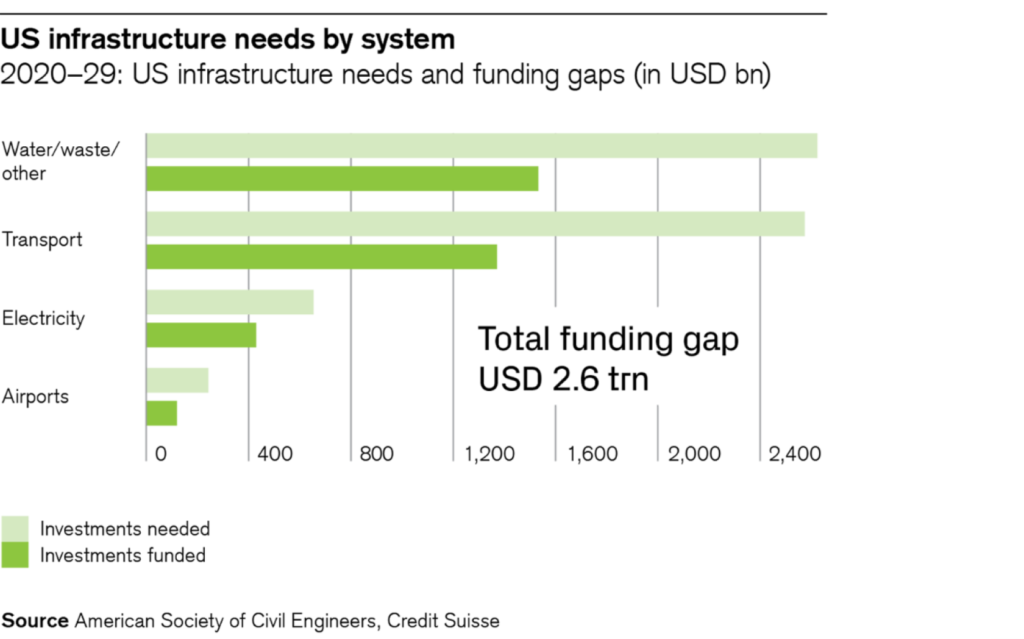Infrastructure spending is an important part of the fiscal stimulus packages that governments around the world are putting in place to revive their economies following the COVID-19 recession. As for infrastructure projects, government focus has shifted to providing more support for sustainable infrastructure investments, as countries attempt to build a greener economy, and placing a greater focus on building climate-resilient infrastructure to protect the investment against the impact of climate change. The recent cold spell that left millions of Texans without power provides a case in point of how extreme weather conditions can impair vital infrastructure.
In the USA, President Joe Biden has unveiled a USD 2.3 trn infrastructure program in addition to his USD 1.9 trn COVID-19 relief package. The proposed infrastructure stimulus contains about USD 700 bn for green initiatives related to electric vehicles infrastructure, electricity networks, energy efficient buildings, green technologies and clean energy manufacturing.
In Europe, the EUR 750 bn European Union (EU) recovery fund is designed to build greener, more digital and more resilient economies, in addition to shoring up struggling sectors. China has already put in place a similarly large fiscal stimulus, which helped it return to economic growth in Q2 2020. Moreover, its pledge to become “carbon neutral” by 2060 signals an important infrastructure investment shift for the country’s 14th Five-Year Plan starting in 2021.
Resilient infrastructure improves the reliability of services, increases the asset life and protects asset returns for investors. Climate resilient construction can involve management measures (such as changing maintenance schedules) as well as structural measures (like raising the height of bridges to account for rising sea levels). In addition, crumbling infrastructure due to underinvestment and lack of maintenance also poses a significant danger and inhibits economic growth.
Climate-proofing mobility
2020 was a difficult year for infrastructure companies, particularly for the transportation sector, which suffered amid the pandemic-related lockdowns. While railroad operators already saw a solid recovery during last year’s COVID-19 related travel disruptions, toll road and airport operators lagged behind due to the collapse in travel demand. The start of vaccination campaigns has raised hopes that 2021 will be a year of recovery for toll road and airport companies as travel demand should rebound once the share of the vaccinated population significantly exceeds the number of new infections.
The pandemic has further delayed necessary infrastructure investments in the transportation sector. The long-term effects associated with chronic underfunding of transportation infrastructure, long known to be a public safety issue, impact a country’s economic growth, employment and competitiveness. The American Society of Civil Engineers (ASCE) estimates that the investment gap between needed and likely investments in US transport infrastructure systems will reach more than USD 1.2 trillion by 2029 and USD 2.5 trillion by 2039.
Future planning of infrastructure construction in the transportation sector has to focus more on the physical impact of climate change. For example, the EU has developed construction and design standards to increase the resilience of road infrastructure in its ROADAPT (“Roads for today adapted for tomorrow”) project. A climate-resilient transportation network takes into account climate aspects such as temperature changes (melting road surfaces and frozen railway lines), rising sea levels (flooding of coastal roads, railways and ports) and changing storm patterns (damage and disruption of bridges and airports).

In modeling the impact of a major flood in Paris, the Organisation for Economic Co-operation and Development (OECD) found that 30%–55% of the direct damage would affect infrastructure assets, while 35%–85% of economic losses would be related to disrupted transportation services and electricity supply rather than the flood itself. Thus, ensuring that transport infrastructure is climate resilient will not only help to lower the direct losses related to climate events, but also reduce the indirect costs of disruption to the infrastructure network.
More information visit www.credit-suisse.com

